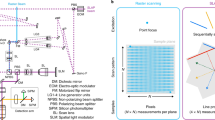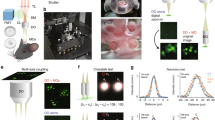Abstract
The understanding of brain computations requires methods that read out neural activity on different spatial and temporal scales. Following signal propagation and integration across a neuron and recording the concerted activity of hundreds of neurons pose distinct challenges, and the design of imaging systems has been mostly focused on tackling one of the two operations. We developed a high-resolution, acousto-optic two-photon microscope with continuous three-dimensional (3D) trajectory and random-access scanning modes that reaches near-cubic-millimeter scan range and can be adapted to imaging different spatial scales. We performed 3D calcium imaging of action potential backpropagation and dendritic spike forward propagation at sub-millisecond temporal resolution in mouse brain slices. We also performed volumetric random-access scanning calcium imaging of spontaneous and visual stimulation–evoked activity in hundreds of neurons of the mouse visual cortex in vivo. These experiments demonstrate the subcellular and network-scale imaging capabilities of our system.
This is a preview of subscription content, access via your institution
Access options
Subscribe to this journal
Receive 12 print issues and online access
$259.00 per year
only $21.58 per issue
Buy this article
- Purchase on Springer Link
- Instant access to full article PDF
Prices may be subject to local taxes which are calculated during checkout





Similar content being viewed by others
References
Johnston, D. & Narayanan, R. Active dendrites: colorful wings of the mysterious butterflies. Trends Neurosci. 31, 309–316 (2008).
Katona, G. et al. Roller Coaster Scanning reveals spontaneous triggering of dendritic spikes in CA1 interneurons. Proc. Natl. Acad. Sci. USA 108, 2148–2153 (2011).
Losonczy, A., Makara, J.K. & Magee, J.C. Compartmentalized dendritic plasticity and input feature storage in neurons. Nature 452, 436–441 (2008).
Spruston, N. Pyramidal neurons: dendritic structure and synaptic integration. Nat. Rev. Neurosci. 9, 206–221 (2008).
Rozsa, B., Katona, G., Kaszas, A., Szipocs, R. & Vizi, E.S. Dendritic nicotinic receptors modulate backpropagating action potentials and long-term plasticity of interneurons. Eur. J. Neurosci. 27, 364–377 (2008).
Rozsa, B., Zelles, T., Vizi, E.S. & Lendvai, B. Distance-dependent scaling of calcium transients evoked by backpropagating spikes and synaptic activity in dendrites of hippocampal interneurons. J. Neurosci. 24, 661–670 (2004).
Ohki, K., Chung, S., Ch'ng, Y.H., Kara, P. & Reid, R.C. Functional imaging with cellular resolution reveals precise micro-architecture in visual cortex. Nature 433, 597–603 (2005).
Ariav, G., Polsky, A. & Schiller, J. Submillisecond precision of the input-output transformation function mediated by fast sodium dendritic spikes in basal dendrites of CA1 pyramidal neurons. J. Neurosci. 23, 7750–7758 (2003).
Cheng, A., Goncalves, J.T., Golshani, P., Arisaka, K. & Portera-Cailliau, C. Simultaneous two-photon calcium imaging at different depths with spatiotemporal multiplexing. Nat. Methods 8, 139–142 (2011).
Durst, M.E., Zhu, G. & Xu, C. Simultaneous spatial and temporal focusing for axial scanning. Opt. Express 14, 12243–12254 (2006).
Holekamp, T.F., Turaga, D. & Holy, T.E. Fast three-dimensional fluorescence imaging of activity in neural populations by objective-coupled planar illumination microscopy. Neuron 57, 661–672 (2008).
Nikolenko, V. et al. SLM microscopy: scanless two-photon imaging and photostimulation with spatial light modulators. Front Neural Circuits 2, 5 (2008).
Gobel, W., Kampa, B.M. & Helmchen, F. Imaging cellular network dynamics in three dimensions using fast 3D laser scanning. Nat. Methods 4, 73–79 (2007).
Kaplan, A., Friedman, N. & Davidson, N. Acousto-optic lens with very fast focus scanning. Opt. Lett. 26, 1078–1080 (2001).
Duemani Reddy, G., Kelleher, K., Fink, R. & Saggau, P. Three-dimensional random access multiphoton microscopy for functional imaging of neuronal activity. Nat. Neurosci. 11, 713–720 (2008).
Grewe, B.F. & Helmchen, F. Optical probing of neuronal ensemble activity. Curr. Opin. Neurobiol. 19, 520–529 (2009).
Grewe, B.F., Langer, D., Kasper, H., Kampa, B.M. & Helmchen, F. High-speed in vivo calcium imaging reveals neuronal network activity with near-millisecond precision. Nat. Methods 7, 399–405 (2010).
Iyer, V., Hoogland, T.M. & Saggau, P. Fast functional imaging of single neurons using random-access multiphoton (RAMP) microscopy. J. Neurophysiol. 95, 535–545 (2006).
Kirkby, P.A., Srinivas Nadella, K.M. & Silver, R.A. A compact acousto-optic lens for 2D and 3D femtosecond based 2-photon microscopy. Opt. Express 18, 13721–13745 (2010).
Otsu, Y. et al. Optical monitoring of neuronal activity at high frame rate with a digital random-access multiphoton (RAMP) microscope. J. Neurosci. Methods 173, 259–270 (2008).
Reddy, G.D. & Saggau, P. Fast three-dimensional laser scanning scheme using acousto-optic deflectors. J. Biomed. Opt. 10, 064038 (2005).
Rozsa, B. et al. Random access three-dimensional two-photon microscopy. Appl. Opt. 46, 1860–1865 (2007).
Salome, R. et al. Ultrafast random-access scanning in two-photon microscopy using acousto-optic deflectors. J. Neurosci. Methods 154, 161–174 (2006).
Vucinic, D. & Sejnowski, T.J. A compact multiphoton 3D imaging system for recording fast neuronal activity. PLoS ONE 2, e699 (2007).
Stosiek, C., Garaschuk, O., Holthoff, K. & Konnerth, A. In vivo two-photon calcium imaging of neuronal networks. Proc. Natl. Acad. Sci. USA 100, 7319–7324 (2003).
Jia, H., Rochefort, N.L., Chen, X. & Konnerth, A. Dendritic organization of sensory input to cortical neurons in vivo. Nature 464, 1307–1312 (2010).
Polsky, A., Mel, B.W. & Schiller, J. Computational subunits in thin dendrites of pyramidal cells. Nat. Neurosci. 7, 621–627 (2004).
Agoston, A. Equivalent time pseudorandom sampling system. Patent US 4678345 (1987).
Christie, J.M., Chiu, D.N. & Jahr, C.E. Ca(2+)-dependent enhancement of release by subthreshold somatic depolarization. Nat. Neurosci. 14, 62–68 (2011).
Nimmerjahn, A., Kirchhoff, F., Kerr, J.N. & Helmchen, F. Sulforhodamine 101 as a specific marker of astroglia in the neocortex in vivo. Nat. Methods 1, 31–37 (2004).
Matsuzaki, M. et al. Dendritic spine geometry is critical for AMPA receptor expression in hippocampal CA1 pyramidal neurons. Nat. Neurosci. 4, 1086–1092 (2001).
Proctor, B. & Wise, F. Quartz prism sequence for reduction of cubic phase in a mode-locked Ti:Al(2)O(3) laser. Opt. Lett. 17, 1295–1297 (1992).
Acknowledgements
We thank A. Csákányi for technical assistance and I. Vanzetta for advice. We thank J. Rátai and D. Rátai for support with the Lenar3Do virtual reality hardware and L. Molnár and G. Karsai for preparing insects. This work was supported by Friedrich Miescher Institute funds, Seventh Framework Programme for Research (FP7) grants (RETICIRC, TREATRUSH, SEEBETTER, OPTONEURO) and a European Research Council grant to Bo.R. and a Marie Curie and EMBO fellowship to D.H., OM-00131/2007, OM-00132/2007, GOP-1.1.1-08/1-2008-0085, a grant of the Hungarian Academy of Sciences, Hungarian-French grant (TÉT_10-1-2011-0389) and Hungarian-Swiss grant (SH/7/2/8).
Author information
Authors and Affiliations
Contributions
Optical design was performed by P.M., G.S. and M.V. Software was written by G.K. In vitro measurements were performed by B.C., A.K., G.S. and Ba.R. In vivo measurements were designed by D.H. and performed by D.H., A.K., G.S. and Ba.R. Analysis was carried out by Ba.R., A.K., G.K. and G.S. This manuscript was written by Ba.R., Bo.R., D.H., G.K., A.K. and P.M., with comments from all authors. Ba.R., Bo.R., E.S.V. and P.M. supervised the project.
Corresponding author
Ethics declarations
Competing interests
G.K., E.S.V. and Ba.R. are owners of Femtonics and the patent WO2010076579.
Supplementary information
Supplementary Text and Figures
Supplementary Figures 1–14, Supplementary Results 1–3, Supplementary Discussion, Supplementary Notes 1–9 and Supplementary Protocols 1–3 (PDF 17819 kb)
Supplementary Video 1
A 3D virtual reality environment for 3D two-photon imaging. This movie shows a surface-fitted pyramidal cell (located in the hippocampal CA1 region) and selected 3D measurement locations used to record the bAP-induced Ca2+ transients shown in Figure 2a. Using the 3D virtual reality environment, the 3D measurement locations can be freely modified or observed from any angle. Head-tracked shutter glasses ensure that the virtual objects maintain a stable, 'fixed' virtual position even when viewed from different viewpoints and angles. That is, the cell's virtual coordinate system is locked in space when the viewer's head position (view angle) changes; however, it can be rotated or shifted by the 3D 'bird' mouse. The bird also allows the 3D measurement points to be picked and repositioned in the virtual 3D space of the cell. (WMV 5934 kb)
Supplementary Video 2
Automatic selection of the measurement points for 3D two-photon imaging in vivo. This movie shows a bulk-loaded cell assembly located in the mouse visual cortex, visualized with real-time maximum-intensity projection in the 3D virtual-reality environment. After detecting putative neuron locations from the stack (see Supplementary Note 5), the experimenter can set the selection threshold with real-time control of the number of selected cells and their localization. (WMV 948 kb)
Supplementary Video 3
Millimeter-range image stack captured without mechanical movement. This movie shows a 3D image stack of neurons from a fluorescently labeled invertebrate ganglion also shown in Figure 1g. While capturing the images, the microscope objective was fixed; images were taken by AO z-focusing. The stack dimensions are 717 μm × 717 μm × 1,071 μm; 40 slices. (WMV 781 kb)
Supplementary Software 1
Use of AD9910. This summary contains information about the usage of the AD9910 DDS chip used to generate frequency signals for the acousto-optic crystals. Wiring to the FPGA, routines used to initialize the chip and Matlab code segments calculating the necessary register values during scanning are incorporated. (ZIP 254 kb)
Supplementary Software 2
A 3D interactive workstation module. This program provides a 3D VR environment with an open-source Matlab interface. It is possible to visualize and interact with 3D MIP projected volume data, surfaces and various annotation objects needed for controlling the experiments and for visualizing the results. It can perform mono or anaglyph views or be used in combination with the Leonar3Do virtual reality hardware. (ZIP 22535 kb)
Supplementary Software 3
Automatic drift-compensation algorithm. Description and code parts used for maintaining scan locations on the cells to measure. (ZIP 16 kb)
Supplementary Software 4
Automatic detection of fluorescently labeled cells. Matlab code identifying cell centers using three dimensional two-channel measurement data was developed for combined OGB-1 and SR-101 bolus loading experiments (Supplementary Note 9 and Supplementary Video 2). Accompanying sample data help evaluate the performance of the code. (ZIP 447 kb)
Rights and permissions
About this article
Cite this article
Katona, G., Szalay, G., Maák, P. et al. Fast two-photon in vivo imaging with three-dimensional random-access scanning in large tissue volumes. Nat Methods 9, 201–208 (2012). https://doi.org/10.1038/nmeth.1851
Received:
Accepted:
Published:
Issue Date:
DOI: https://doi.org/10.1038/nmeth.1851
This article is cited by
-
Dual-resonant scanning multiphoton microscope with ultrasound lens and resonant mirror for rapid volumetric imaging
Scientific Reports (2023)
-
High-speed multiplane confocal microscopy for voltage imaging in densely labeled neuronal populations
Nature Neuroscience (2023)
-
Optical gearbox enabled versatile multiscale high-throughput multiphoton functional imaging
Nature Communications (2022)
-
Optically addressable universal holonomic quantum gates on diamond spins
Nature Photonics (2022)
-
Fast optical recording of neuronal activity by three-dimensional custom-access serial holography
Nature Methods (2022)



